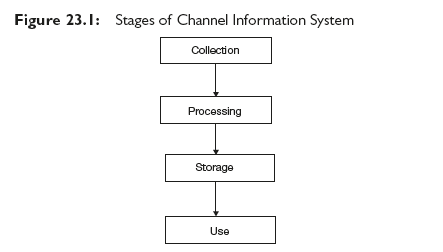A Channel Information System provides information about the day-to-day sales of products, SKU-wise sales, information about the transactions by different channel partners, and about inventory levels. The main purpose of CIS is to improve decision making by providing appropriate information and reducing uncertainty. Figure 23.1 show the stages of CIS.
Collection. Collection of cross-channel customer information is one of the most crucial parts of successful CIS. Collection of right information at the right time is the backbone of the CIS. Massive data is available in the transactions of the company with the distributors and retailers. This data can be monthly sales, product sales, payment history, and response to the different marketing campaigns. Many companies collect data on primary sales and secondary sales to analyze the sales pattern in the different territories. It is important to build trust with the channel partners to collect the desired data. The way of collecting data as as important as the data itself. Few companies are incentivising the process (frequency, method, amount of data, etc.) of collecting data from channel partners. Companies are using advanced softwares to capture customer data, but the collection of customer data is useless if that data is redundant or incorrect. Many companies employ regular data hygiene techniques to ensure accuracy of the collected data. Companies are using sophisticated information technology systems like barcode, RFID to capture customer data.

Processing. Processing of the data in the right manner helps in the right analysis of the data. Processing of data is related to arrangement, modification, and interpretation of the data by the users. It is vital to process the channel sales data accurately, efficiently and satisfactorily. Data processing errors can result in flawed decision making, increased costs, customer dissatisfaction, and can affect the bottom line. Processing of data in CIS helps in decision making of different activities related to channel members. Examples can be a comparison of product sales during different periods or comparison of channel responses to different sales promotional techniques like bonus offers, sales contests.
Storage. We are living in an information-centric world where it is vital that data is stored to back-up information and it can be distributed quickly, if and when required. The information related to channel management and channel partners can be stored via information technology platforms, software resources, and storage hardware. Companies are using new-age tools like clouds, virtualization, and storage networks for data storage while reducing costs. Old sales data is critical for forecasting.
Use. The main purpose of CIS is to help decision making on the basis of the data generated from various transactions in the channel management. Com-pany can use the data for many purposes like customer segmentation, loyalty programs, forecasting, credit policies, sales contests, SKU-wise sales planning, territory planning, expense controls, merchandising planning among others.
Source: Richard R. Still, Edward W. Cundliff, Normal A. P Govoni, Sandeep Puri (2017), Sales and Distribution Management: Decisions, Strategies, and Cases, Pearson; Sixth edition.

I savour, cause I discovered exactly what I used to be taking a look for. You have ended my four day lengthy hunt! God Bless you man. Have a nice day. Bye